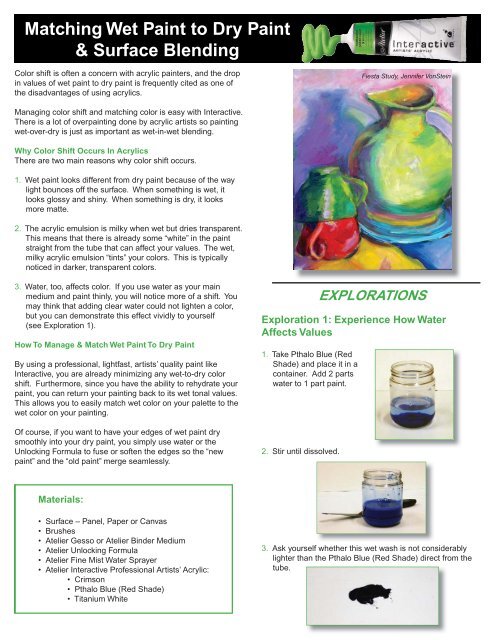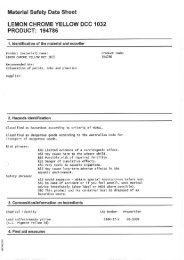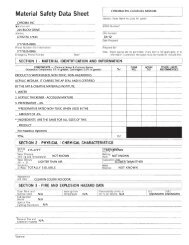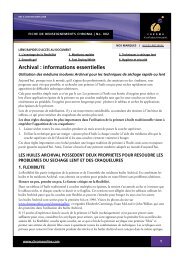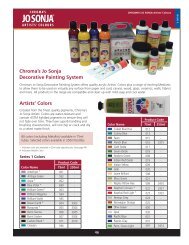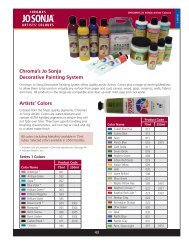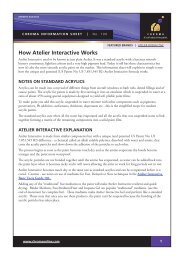Matching Wet Paint To Dry Paint & Surface Blending.indd - Dick Blick
Matching Wet Paint To Dry Paint & Surface Blending.indd - Dick Blick
Matching Wet Paint To Dry Paint & Surface Blending.indd - Dick Blick
- No tags were found...
You also want an ePaper? Increase the reach of your titles
YUMPU automatically turns print PDFs into web optimized ePapers that Google loves.
<strong>Matching</strong> <strong>Wet</strong> <strong>Paint</strong> to <strong>Dry</strong> <strong>Paint</strong>& <strong>Surface</strong> <strong>Blending</strong>Color shift is often a concern with acrylic painters, and the dropin values of wet paint to dry paint is frequently cited as one ofthe disadvantages of using acrylics.Fiesta Study, Jennifer VonSteinManaging color shift and matching color is easy with Interactive.There is a lot of overpainting done by acrylic artists so paintingwet-over-dry is just as important as wet-in-wet blending.Why Color Shift Occurs In AcrylicsThere are two main reasons why color shift occurs.1. <strong>Wet</strong> paint looks different from dry paint because of the waylight bounces off the surface. When something is wet, itlooks glossy and shiny. When something is dry, it looksmore matte.2. The acrylic emulsion is milky when wet but dries transparent.This means that there is already some “white” in the paintstraight from the tube that can affect your values. The wet,milky acrylic emulsion “tints” your colors. This is typicallynoticed in darker, transparent colors.3. Water, too, affects color. If you use water as your mainmedium and paint thinly, you will notice more of a shift. Youmay think that adding clear water could not lighten a color,but you can demonstrate this effect vividly to yourself(see Exploration 1).How <strong>To</strong> Manage & Match <strong>Wet</strong> <strong>Paint</strong> <strong>To</strong> <strong>Dry</strong> <strong>Paint</strong>By using a professional, lightfast, artists’ quality paint likeInteractive, you are already minimizing any wet-to-dry colorshift. Furthermore, since you have the ability to rehydrate yourpaint, you can return your painting back to its wet tonal values.This allows you to easily match wet color on your palette to thewet color on your painting.Of course, if you want to have your edges of wet paint drysmoothly into your dry paint, you simply use water or theUnlocking Formula to fuse or soften the edges so the “newpaint” and the “old paint” merge seamlessly.Exploration 1: Experience How WaterAffects Values1. Take Pthalo Blue (RedShade) and place it in acontainer. Add 2 partswater to 1 part paint.2. Stir until dissolved.EXPLORATIONSMaterials:• <strong>Surface</strong> – Panel, Paper or Canvas• Brushes• Atelier Gesso or Atelier Binder Medium• Atelier Unlocking Formula• Atelier Fine Mist Water Sprayer• Atelier Interactive Professional Artists’ Acrylic:• Crimson• Pthalo Blue (Red Shade)• Titanium White3. Ask yourself whether this wet wash is not considerablylighter than the Pthalo Blue (Red Shade) direct from thetube.
Exploration 2: <strong>Matching</strong> Color - <strong>Wet</strong> Color<strong>To</strong> <strong>Dry</strong> Color/Adjusting Values1. On your palette, create a mixture of 80% Crimson and20% Titanium White. On a surface that has beenprepared with Binder Medium or Gesso, paint a swatch.Note the wet color.Exploration 3: <strong>Surface</strong> <strong>Blending</strong>When you are blending oil paint and you have a thickapplication of wet paint on the canvas, if you blend into it, thelikelihood of producing mud is high because you are mixinginto a whole layer of wet paint.When you are using Interactive, if you wait until your painttacks up, you will fi nd that you can moisten the surfaceenough to blend what you want to without disturbing thewhole layer of paint.<strong>Surface</strong> <strong>Blending</strong> is a special new attribute that not even oilpainters have access to.2. Wait 10 to 20 minutes or until touch-dry. Using the FineMist Water Sprayer fi lled with water, spray your swatchuntil your paint is workable. Note how the mixture returnsto its light, wet value.1. Use the Crimson andTitanium White swatchfrom the previousexploration. Make sureit is touch-dry.3. Mix a new batch of 80% Crimson and 20% Titanium Whiteon your palette. Compare the new batch to the wet paintswatch. <strong>Paint</strong> into the wet swatch. Note how easy it wasto match the wet color on the palette to the wet swatch.2. Using the Fine MistWater Sprayer fi lledwith water or theUnlocking Formula,spray your swatchuntil the paint feelsworkable.4. Wait 5 to 10 minutes or until touch-dry. Rehydrate yourswatch again until its workable. This time, add moreTitanium White into the swatch in order to adjust the tonalvalue.3. In the center, blend inPthalo Blue (Red Shade)to make a light violet color.Note how you just activatethe surface layer, whichhelps to prevent mud.Interactive cures in about 7 to 14 days depending onhow thickly you paint, your surface, the humidity andthe mediums you have used. As your painting goesthrough the curing cycle, you may need to use theUnlocking Formula to reopen touch-dry paint.Chroma, Inc205 Bucky Drive, Lititz, PA 175431-800-257-8278 • www.chromaonline.com


